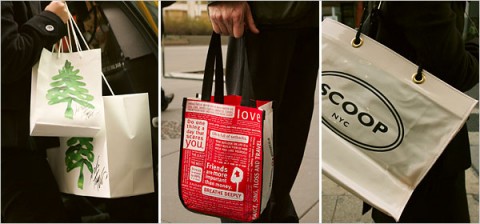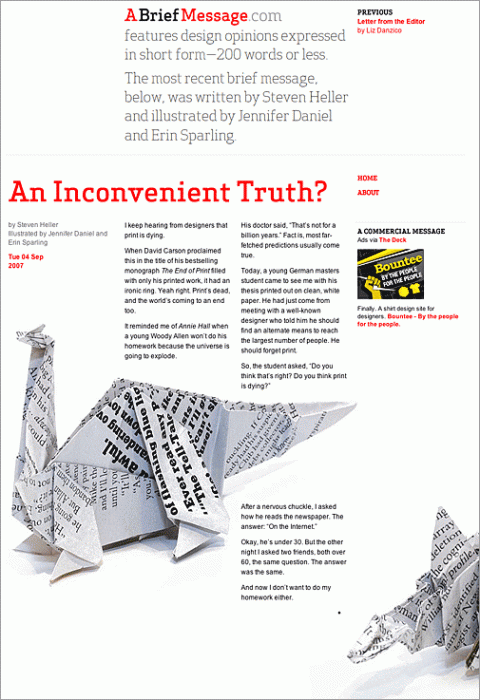As good design further penetrates the Web, once highly-regarded conventions fall into disfavor and are replaced by more effective ones. Yet some flawed conventions persist. In fact, they persist on some pretty high-profile websites; to their detriment.
The Heart of the Matter
Should our creative briefs be drafted solely around the desired end reaction? We could delete the delivery device and focus solely on creating meaningful interaction with the audience. This might make the notion of hourly billings anachronistic. Our clients demand results, not labour. Why aren’t we pricing our value as such?
While the world around us continues to change, the one thing that remains constant is that people act as a result of their emotions. As visual communicators, we’re in the business of crafting reactions. If we can embrace this truth, we’ll do our clients and ourselves a great service.
Design Matters Season Five Launches on January 18th!
I am thrilled to learn that Design Matters by Debbie Millman will start it’s fifth season in only a few days. The first half of Season Five will run from January 18th until April 25th and the second half of Season Five will begin in September. Design Matters airs live weekly on the Voice America Business Network. The show is also available as Podcasts on iTunes.
Season Five will feature acclaimed graphic designers, writers, illustrators, authors, scientists, editors, and even a Nobel Prize winner. The line-up includes: Chip Kidd, Eric Kandel, Kurt Andersen, Vaughan Oliver and many more. See the entire line up here.
YAY! Debbie! Can’t wait to hear your shows!
Never Mind What’s in Them, Bags Are the Fashion
Retailers are giving shopping bags a makeover, turning consumers into walking ads. At left, Lord & Taylor bags; center, a bag from Lululemon Athletica; at right, the Scoop bag.
Once a flimsy afterthought in American retailing — used to lug a purchase home from the store, then tossed into the trash — the lowly, free store bag is undergoing a luxurious makeover.
Never Mind What’s in Them, Bags Are the Fashion, by Michael Barbaro for the NYTimes
Seventy-nine Short Essays on Design
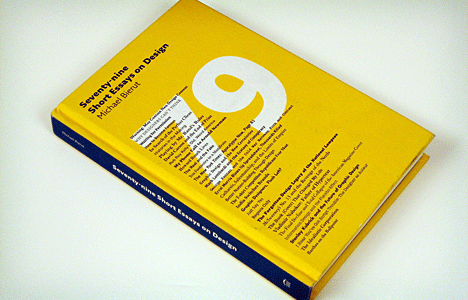
Looking for a good gift for a ‘designer friend’? Seventy-nine Short Essays on Design, by Michael Bierut
10 Ways To Get Design Approval
10 Ways To Get Design Approval by Paul Boag
(via andy)
Dieter Rams 10 Commandments of Design:
Good design is innovative
Good design makes a product useful
Good design is aesthetic
Good design helps a product to be understood
Good design is unobtrusive
Good design is honest
Good design is durable
Good design is consistent to the last detail
Good design is concerned with the environment
Good design is a s little design as possible(via perpenduum)
Why RFPs are bad for designers
…The worst kind of business, in my humble opinion, is that which beckons in the form of an RFP. For those who aren’t familiar with RFPs – I can’t imagine many who aren’t – the acronym is derived from “Request For Proposals”. Talk to most experienced design managers and they’ll feel similarly: RFPs simply don’t work when it comes to purchasing design services. RFP, R.I.P., by Eric Karjaluoto
Rethinking Wicked Problems (Part 2)
Excerpts from the 30th and final conversation Rethinking Wicked Problems (part 2), Unpacking Paradigms, Bridging Universes:
Jeff Conklin: “I agree with GK that there is an alarming pattern away from dialogue and deliberation in politics and the mainstream media, and the glorification of debate and right/wrong interaction styles in the blogsphere. But I suspect that these very patterns are waking up more and more people to the ultimately self-destructive (and ineffective) nature of dualistic thinking, and are highlighting the need for creative and more inclusive modes of thought and communication.”
Min Basadur: “I welcome Roger Martin and Rotman awakening to the potential and power of applied creativity. I view the statement by Martin that you made reference to as part of a genuine effort being made by a business school leader to become more relevant. Is there anything new there? Not really. I know that some business school leaders seem to think that “The Creative Age” just arrived last year but from our perspective that is more about creative marketing then creative reality. That is more about some business schools and their leaders arriving in the creative age then it is about the arrival of the creative age.”
GK VanPatter: “While the starting point in Design 1.0 and 2.0 was often a challenge framed by others the Design 3.0 activity space presents a radically different paradigm in that it encompasses participation and leadership on the fuzzy strategic front end, long before challenges are framed.”
NextD Journal | Rethinking Wicked Problems (Part 2)
Khoi Vinh | Control
Annotated version of Khoi’s slides from his fabulous talk Control at the AIGA National Design Conference last week. A larger version of this deck is available directly at this SlideShare link.
first design view podcast by andy rutledge
The Design View Show is a weekly podcast by Andy Rutledge, examining design fundamentals, business, culture, and professionalism.
(Thank you Christopher)
It’s not them; it’s us (sometimes)
I once worked in retail with a fellow whom customers loved. His trick seemed to be found in how often he said “yes”. A customer would come in with an outdated coupon and he’d accept it. When people wanted something done in a rush, he’d smile and find a way to do it. As a result, people started to ask for him by name. The company sold more product due to his accommodating disposition.
Clients love to hear that something isn’t a problem. Just starting with a “yes” opens things up. This is helpful should you find that their approach doesn’t accomplish what they had hoped, and you need to sell them on another possibility. A mistimed “no”, on the other hand, can sometimes result in a tug of war.
Becoming a Digital Designer
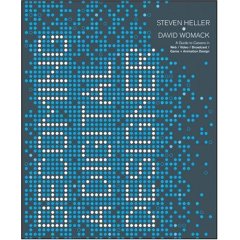
Authors Steven Heller and David Womack give you a comprehensive guide to the individuals, tools, and trends that are shaping digital design, and so provide an essential resource for anyone considering a career in the field. They look at the many areas of the digital design market, covering everything from the education and training you’ll need, design specialties to consider, and the different work settings that may influence your choices. They tell you how to prepare an effective portfolio; how to find a job in your chosen specialty; and what you’ll need to advance in your career.
Becoming a Digital Designer: A Guide to Careers in Web, Video, Broadcast, Game and Animation Design , by Steven Heller (Author), David Womack (Author)
TED talk: John Maeda | Simplicity patterns
The MIT Media Lab’s John Maeda lives at the intersection of technology and art — a place that can get very complicated. Here, he talks about paring down to basics, and how he creates clean, elegant art, websites and web tools. In his book Laws of Simplicity, he offers 10 rules and 3 keys for simple living and working — but in this talk, he boils it down to one simply delightful way to be.
Designs for Working | Malcolm Gladwell
The parallels between neighborhoods and offices are stiking. There was a time, for instance, when companies put their most valued employees in palatial offices, with potted plants in the corner and secretaries out front, guarding access. Those offices were suburbs – gated communities, in fact – and many companies came to realize that if their best employees were isolated in suburbs they would be deprived of public acquaintanceship, the foundations of public trust, and cross connections with the necessary people.
I just stumbled upon this fantastic New Yorker article by Malcolm Gladwell from 2000: Why your bosses want to turn your new office into Greenwich Village (PDF)
New Minimalism in web interface design
Web minimalism has come back as a trend in the summer of 2007. Rainfall Daffinson adores the concept of minimalism (so does swissmiss). They chose 24 moments of minimalism web interface design in the last decade, selected several quotes to easily define the minimalism and represent some of the best new minimalism websites.
Whose Red Cross to Bear?
 In early August, the medical supplies and drug firm Johnson & Johnson sued the American Red Cross over the right to use the red-cross emblem. Most of us had assumed that the red cross, seen on ambulances and first-aid kits, was a universal symbol of succor to the suffering. But like any graphic symbol, the red cross turns out to have more meanings and more history than would at first appear. And the rights to use this symbol are equally complicated—a reminder that many graphic symbols have more complex stories than we expect.
In early August, the medical supplies and drug firm Johnson & Johnson sued the American Red Cross over the right to use the red-cross emblem. Most of us had assumed that the red cross, seen on ambulances and first-aid kits, was a universal symbol of succor to the suffering. But like any graphic symbol, the red cross turns out to have more meanings and more history than would at first appear. And the rights to use this symbol are equally complicated—a reminder that many graphic symbols have more complex stories than we expect.
Whose Red Cross to Bear?, by Phil Patton
Simple is best
Simple websites are easy to use, easy to understand, nice to look at. In practice, websites are either unusable or ugly and in general filled with too many complicated words. Why do designers have such a hard time to keep it simple?
Simple is best, by Oliver Reichenstein
50 Designers x 6 Questions
What are the things you should know before starting designing / programming? What things should you be aware of? How to get your project done? 50 Designers x 6 Questions
(via popwuping)
a brief message
Khoi and Liz have been cooking up a new website, called A Brief Message. The first entry was written by Steven Heller. The site features design opinions expressed in short form—200 words or less. Fantastic!
A new favorite and instantly added to my ‘recommended’ list on the left. Hat tip!
what does next mean?
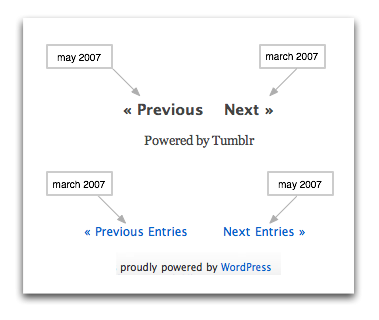
Tumblr: previous means show me more recent entries. What matters is browsing, history. WordPress: previous means show me older entries. What matters is date, publishing. What does next mean?
Design Brief
Your design can only be as good as the brief you worked from. The best projects are borne from briefs that are open enough to inspire ideas, while being specific enough to feel workable. Shaun Crowley shows how you can elicit these kinds of briefs by providing clients with briefing templates.
